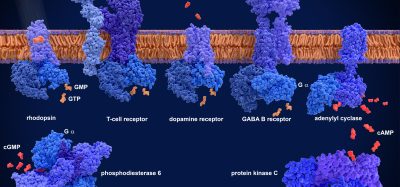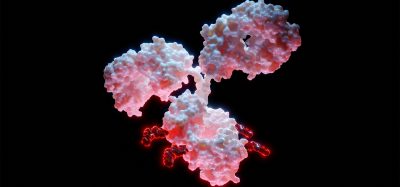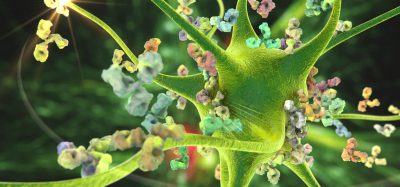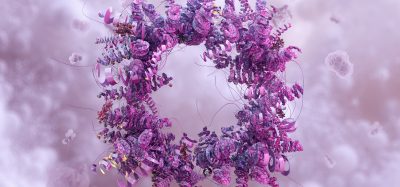Targeting GAS6 in cancer, fibrosis and viral infection
Posted: 9 March 2017 | Amato J Giaccia (Stanford University), Raymond Tabibiazar (Aravive Biologics Inc), Rebecca Miao (Stanford University) | No comments yet
The growth-arrest specific 6 (GAS6) protein has emerged in recent years as an attractive target for drug development primarily because it is the sole ligand for the AXL receptor tyrosine kinase, which plays critical roles in cancer, fibrosis, and viral infection.


Furthermore, research has shown that elevated GAS6 levels and activation of AXL signalling both correlate with poor prognosis, more invasive disease, and resistance to chemotherapy, radiation, and targeted therapies.[1]
Evidence that GAS6, via AXL activation, is a key driver of epithelial-mesenchymal transition (EMT) has heightened interest in efforts to inhibit this critical ligand-receptor interaction because research has found many cancers utilise EMT during invasion and metastasis,[2] as well as chemoresistance. Additional research has revealed the relationship between GAS6-mediated AXL signalling and the DNA damage response. Modulation of this biological process is a compelling prospect for drug development because diminished signalling may boost the efficacy of chemotherapies in a variety of human cancers.[3]
In addition to its role in regulating EMT, the GAS6/AXL pathway can also modulate tumour growth and progression via regulation of fibrosis.[4] Recent studies have indicated that GAS6 concentration correlates directly to liver stiffness in patients with fibrosis and that the ligand may play a role in the pathogenesis and progression of steatohepatitis and fibrosis.[5]
Adding to the appeal of GAS6 as a drug target is the relatively recent discovery that GAS6 inhibitors of TAM have antiviral properties that may help reduce transmission of some of the most troublesome emerging viruses. These include dengue, West Nile, Ebola, lentivirus, and most recently, Zika.[6]
TAM and GAS6 background
The TAM family of receptor tyrosine kinases (RTKs) derives its name from the first letters of its constituents – TYRO3, AXL, and MERTK. Research has implicated all three receptors in tumour growth, but AXL has been shown to play the leading role in driving cancer metastasis and acquired drug resistance.
Together, GAS6 and AXL form what is often referred to as the GAS6/AXL signalling pathway. Many human cancers exhibit upregulation of this pathway, including lung, breast, ovarian, pancreatic, and kidney, as well as both acute and chronic myeloid leukaemia. AXL signalling is activated almost exclusively through the binding of GAS6 to its N-terminal extracellular immunoglobulin-like domain, which promotes tumour progression, metastasis and drug resistance in many forms of human cancers.1,[7]
|
Cancer |
AXL/GAS6 |
Validation references |
|
AML, CML |
>35 |
|
|
Pancreas |
50-70 |
|
|
Ovarian |
50-90 |
|
|
Kidney |
>75 |
|
|
Breast |
76-90 |
Zhang et al, 2008;[16] Berclaz et al, 2001;[17] McCormack et al, 2008[18] |
|
Lung |
45-93 |
Shieh et al, 2005;[19] Wimmel et al, 2001;[20] Linger et al, 2012[21] |
|
Table 1: Examples of human cancers in which upregulation of Gas6/AXL signalling has been demonstrated clinically |
||
Similarly, GAS6 levels are frequently found to be elevated in cancer, and often indicate poor prognosis and decreased survival times.[22],[23],[24] GAS6 elevation is also associated with a variety of disease states, including venous thromboembolic disease, chronic renal failure, and preeclampsia.[25],[26],[27] Additional clinical conditions implicated in AXL dysfunction include chronic immune disorders, such as rheumatoid arthritis and systemic lupus erythematosus, and cardiovascular conditions such as stroke, acute coronary syndrome and abdominal aortic aneurysm.[28],[29]
Attempts to inhibit the GAS6/AXL signalling pathway include three basic strategies, each with their own benefits and limitations:
- Small molecules that block AXL signalling
- Antibodies that bind and neutralise either GAS6 or AXL directly, and antibody drug conjugates (ADCs) that bind AXL, preferentially on cancer cells
- Soluble decoy receptors that attract GAS6 with greater affinity than cell surface AXL.
Small molecules
Small-molecule therapies offer direct anti-tumour activity and a well-known chemistry (kinase inhibitors) – both attractive prospects for any drug development program. However, there are at least 59 RTKs encoded in the human genome, and small molecules aimed selectively at TAM and AXL often run into problems of specificity and interfere with other critical biological functions.
|
Small molecule |
Company |
Mechanism(s) of action |
Treatment indication |
Development phase |
|
ASP2215 |
Astellas Pharma and Kotobuki Pharmaceutical |
FLT3, LTK, ALK, and AXL tyrosine kinase inhibitor |
Relapsed or refractory acute myeloid leukaemia (AML) with FLT3 mutation |
Phase III |
|
MGCD265 |
Mirati Therapeutics |
AXL and MET receptor tyrosine kinase inhibitor |
NSCLC and solid tumors |
Phase II |
|
BGB324 |
BerGenBio A/S and Rigel Pharmaceuticals |
AXL, MERTK, ABL, RET, TIE2, FLT3 |
NSCLC, AML, and melanoma |
Phase I |
|
TP-0903 |
Tolero Pharmaceuticals |
AXL, AURKA, AURKB, JAK2, ALK, ABL1 |
Leukemia and pancreatic cancer |
Phase I |
|
Table 2: A select number of small molecule AXL inhibitors currently in development. A longer list of non-selective kinase inhibitors with activity against AXL is not included. |
||||
The major problem with small-molecule therapies designed as selective inhibitors for AXL is a high degree of homology among the kinase receptor domains of TAM family members. Small molecules are liable to block or restrict other important signalling molecules, causing serious and potentially dose-limiting side effects, such as hypertension through the VEGF pathway or irreversible blindness through the MERTK pathway.[30]
Additionally, determination of dose-limiting side effects is difficult to forecast during the design phase, making small-molecule development a financial liability that generates off-target toxicity not knowable until mid-stage clinical development.
Antibodies and ADCs
Much like the small-molecule approach, monoclonal antibodies (mAbs) and ADCs for AXL and GAS6 have shown promise, but come with their own technical challenges that make it difficult to achieve therapeutic efficacy. The US Food and Drug Administration (FDA) approved the first mAb in the mid-1980s, and over the next 35 years the FDA granted or authorised investigational-new-drug status to more than 400 mAbs to treat a variety of diseases.
|
Compound |
Sponsor/developer |
Mechanism |
|
YW327.6S2 |
Genentech |
Binds to AXL, downregulating AXL expression, inhibiting activation, signalling, and Gas6-dependent Baf3-AXL cell proliferation |
|
Anti-AXL D9 and E8 |
Institut de Recherche en Cancérologie de Montpellier Université |
Inhibits phosphorylation of AXL and its downstream target, AKT, without affecting GAS6 binding; induces down-expression of AXL by internalization |
|
HuMax-AXL-ADC |
Genmab |
Combines high-affinity human mAb against AXL with clinically validated cytotoxic drug from Seattle Genetics |
|
GMAB1 and GMAB2 |
Amgen |
Purified human antibodies, isolated from murine hybridomas, that bind to GAS6 and block TAM/AXL signalling |
|
Table 3: Sampling of receptor antibodies and antibody-drug conjugates targeting AXL/GAS6 |
||
Recently, however, biomedical researchers have introduced further refined antibody therapies, which are capable of even greater selectivity and targeted delivery of cytotoxic compounds. These second- and third-generation antibody therapies include ADCs, bi- and multi-specific antibodies, and others. Such engineered compounds often combine the antigen-specific targeting of mAbs with the cancer-killing ability of cytotoxic drugs, leveraging the antibody’s precision to both block a unique signalling pathway and selectively deliver chemotherapeutic agents.
The main benefit of this approach is that the drugs directly target cancer cells, binding to the tumour surface to interrupt AXL signalling and induce apoptosis. While effective against a variety of tumour receptor antigens, a major hurdle in targeting AXL is the unusually high 30pM affinity of Gas6 for AXL.3 Unless the antibody induces receptor internalisation, an effective antibody-based therapy against AXL would likely require a minimum 5pM affinity to be able to outcompete the natural ligand-receptor interaction.
Soluble decoy receptors
An alternative approach for inhibiting AXL signalling is to leverage the native molecular interactions between GAS6 and AXL to overcome many of the above-mentioned challenges. The soluble decoy receptor approach has the potential to offer complete target coverage without affecting other critical RTK pathways. In addition to overcoming the selectivity and potency challenges of small molecules and antibodies, the soluble decoy receptor approach, by which hAXL receptor is fused to hIgG1 Fc, leverages a clinically validated strategy to achieve good pharmacokinetic properties and to reduce clinical/regulatory risk.


Aravive-S6 is an engineered soluble AXL receptor hIgG1 Fc fusion protein. To overcome the strong binding between GAS6 and AXL (30pM), Aravive-S6 was engineered with a ~100 femtomolar affinity for GAS6 at roughly 300 times the strength of the native interaction. In preclinical studies to date, Aravive-S6 (also known as MYD1-A72V) has shown significant in vivo efficacy in multiple tumour types, no safety issues, good tolerability in mice and non-human primates, stability in circulation, and pharmacokinetic-pharmacodynamic relationships consistent with intravenous dosing in humans.
Summary
Despite the technical challenges associated with developing a selective and potent therapy to target AXL/GAS6 signalling, this biology remains an attractive target for drug development, and many leading pharmaceutical companies are working along a variety of platforms to achieve that goal. Each of the approaches currently being pursued – small molecules, monoclonal antibodies and ADCs, and decoy receptors – have their benefits and limitations.
Aravive-S6 represents a differentiated approach to targeting the protein’s sole activating ligand, rather than the receptor itself. In antagonising the ligand-receptor interaction, Aravive-S6 holds the potential to serve as a new biologic therapy for multiple cancers, particularly the treatment of aggressive and resistant varieties. In addition, soluble AXL decoy receptors may also prove to be efficacious in non-oncology indications such as fibrosis, where safety would be paramount, and potentially as a new first-in-class pan-viral treatment for many of the troublesome emerging viruses.
BIOGRAPHIES






REFERENCES
[1] Axelrod H, Pienta KJ. Axl as a mediator of cellular growth and survival. Oncotarget. 2014;5(19): 8818-8852
[2] Rankin EB, Giaccia AJ. The receptor tyrosine kinase AXL in cancer progression. Cancers (Basel). 2016;8(11): 103
[3] Kariolis MS, Miao YR, Diep A, et al. Inhibition of the GAS6/AXL pathway augments the efficacy of chemotherapies. J Clin Invest. 2017;127(1): 183-198
[4] Fourcot A, Couchie D, Chobert MN, et al. Gas6 deficiency prevents liver inflammation, steatohepatitis, and fibrosis in mice. Am J Physiol Gastrointest Liver Physiol. 2011;300(6): 1043-1053.
[5] Bárcena C, Stefanovic M, Tutusaus A. Gas6/Axl pathway is activated in chronic liver disease and its targeting reduces fibrosis via hepatic stellate cell inactivation. J Hepatol. 2015;63(3): 670-678
[6] Meertens L, Labeau A, Dejarnac O. Axl mediates Zika virus entry in human glial cells and modulates innate immune responses. Cell Rep. 2017;18(2): 324-333
[7] Sasaki T, Knyazev PG, Clout NJ, et al. Structural basis for Gas6-Axl signaling. EMBO J. 2006;25(1): 80–87
[8] Rochlitz C, Lohri A, Bacchi M, et al. Axl expression is associated with adverse prognosis and with expression of Bcl-2 and CD34 in de novo acute myeloid leukemia (AML): results from a multicenter trial of the Swiss Group for Clinical Cancer Research (SAKK). Leukemia 1999;(13): 1352–1358
[9] Gioia R, Trégoat C, Dumas PY, et al. CBL controls a tyrosine kinase network involving AXL, SYK and LYN in nilotinib-resistant chronic myeloid leukaemia. J Pathol. 2015;237(1): 14-24
[10] Song X, Wang H, Logsdon CD, et al. Overexpression of receptor tyrosine kinase Axl promotes tumor cell invasion and survival in pancreatic ductal adenocarcinoma. Cancer. 2011;117(4): 734-43
[11] Koorstra JB, Karikari CA, Feldmann G, et al. The Axl receptor tyrosine kinase confers an adverse prognostic influence in pancreatic cancer and represents a new therapeutic target. Cancer Biol Ther. 2009;8(7): 618-26
[12] Rankin EB, Fuh KC, Taylor TE, et al. AXL is an essential factor and therapeutic target for metastatic ovarian cancer. Cancer Res. 2010;70(19) :7570-7579
[13] Sun W, Fujimoto J, Tamaya T. Coexpression of Gas6/Axl in human ovarian cancers. Oncology. 2004;66(6): 450-7
[14] Gustafsson A, Martuszewska D, Johansson M, et al. Differential expression of Axl and Gas6 in renal cell carcinoma reflecting tumor advancement and survival. Clin Cancer Res. 2009;15(14): 4742-4249
[15] Chung BI, Malkowicz SB, Nguyen TB, Libertino JA, McGarvey TW. Expression of the proto-oncogene Axl in renal cell carcinoma. DNA Cell Biol. 2003 Aug;22(8): 533-40
[16] Zhang YX, Knyazev PG, Cheburkin YV. AXL is a potential target for therapeutic intervention in breast cancer progression. Cancer Res. 2008;68(6): 1905-1915
[17] Berclaz G, Altermatt HJ, Rohrbach V, Kieffer I, Dreher E, Andres AC. Estrogen dependent expression of the receptor tyrosine kinase axl in normal and malignant human breast. Ann Oncol. 2001;12(6): 819-824
[18] Mc Cormack O, Chung WY, Fitzpatrick P, et al. Growth arrest-specific gene 6 expression in human breast cancer. Br J Cancer. 2008;98(6): 1141-1146
[19] Shieh YS, Lai CY, Kao YR, et al. Expression of axl in lung adenocarcinoma and correlation with tumor progression. Neoplasia. 2005;7(12): 1058-1064
[20] Wimmel A, Glitz D, Kraus A, Roeder J, Schuermann M. Axl receptor tyrosine kinase expression in human lung cancer cell lines correlates with cellular adhesion. Eur J Cancer. 2001;37(17): 2264-2274
[21] Linger RM, Cohen RA, Cummings CT, et al. Mer or Axl receptor tyrosine kinase inhibition promotes apoptosis, blocks growth and enhances chemosensitivity of human non-small cell lung cancer. Oncogene. 2013;32(29): 3420-3431
[22] Hattori S, Kikuchi E, Kosaka T, et al. Relationship Between Increased Expression of the Axl/Gas6 Signal Cascade and Prognosis of Patients with Upper Tract Urothelial Carcinoma. Ann Surg Oncol. 2016;23(2): 663-670
[23] Ishikawa M, Sonobe M, Nakayama E, et al. Higher expression of receptor tyrosine kinase Axl, and differential expression of its ligand, Gas6, predict poor survival in lung adenocarcinoma patients. Ann Surg Oncol. 2013;Suppl 3: S467-S476
[24] Jiang T, Liu G, Wang L, Liu H. Elevated serum Gas6 is a novel prognostic biomarker in patients with oral squamous cell carcinoma. PLoS One. 2015;10(7): e0133940
[25] Blostein MD, Rajotte I, Rao DP, Holcroft CA, Kahn SR. Elevated plasma gas6 levels are associated with venous thromboembolic disease. J Thromb Thrombolysis. 2011;32(3): 272-278
[26] Lee IJ, Hilliard B, Swami A, et al. Growth arrest-specific gene 6 (Gas6) levels are elevated in patients with chronic renal failure. Nephrol Dial Transplant. 2012;27(11): 4166-4172
[27] Liu X, Gong Y, Jia J, et al. Plasma concentrations of sAxl are associated with severe preeclampsia. Clin Biochem. 2014;47(3): 173-176
[28] Gheita TA, Bassyouni IH, Bassyouni RH, et al. Plasma concentrations of growth arrest specific protein 6 and the soluble form of its tyrosine kinase receptor Axl in patients with systemic lupus erythematosus and Behçets disease. J Clin Immunol. 2012;32(6): 1279-1286
[29] Korshunov VA. Axl-dependent signaling: a clinical update. Clin Sci (Lond). 2012;122(8): 361-368
[30] Prasad D, Rothlin CV, Burrola P, et al. TAM receptor function in the retinal pigment epithelium. Mol Cell Neurosci. 2006;33(1): 96-108
Related topics
Ligands, Target Validation
Related organisations
Stanford University







